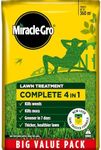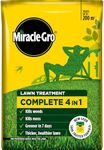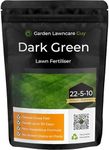Buying Guide for the Best Grass Fertilizers
Choosing the right grass fertilizer is essential for maintaining a healthy and lush lawn. Fertilizers provide the necessary nutrients that grass needs to grow strong and green. When selecting a fertilizer, it's important to understand the different types and their specific benefits. This will help you make an informed decision based on your lawn's needs and conditions.N-P-K RatioThe N-P-K ratio represents the percentage of nitrogen (N), phosphorus (P), and potassium (K) in the fertilizer. Nitrogen promotes leaf growth and vibrant green color, phosphorus supports root development, and potassium enhances overall health and disease resistance. For a lush lawn, a higher nitrogen content is often preferred. However, the right ratio depends on your lawn's specific needs. For example, new lawns benefit from higher phosphorus for root establishment, while established lawns may need more nitrogen for green growth.
Type of FertilizerFertilizers come in various forms, including granular, liquid, and organic. Granular fertilizers are easy to apply and provide a slow release of nutrients over time. Liquid fertilizers offer quick absorption and immediate results but may require more frequent application. Organic fertilizers are made from natural sources and improve soil health in addition to providing nutrients. Choose the type based on your preference for application and the specific needs of your lawn.
Release RateThe release rate indicates how quickly the nutrients are made available to the grass. Slow-release fertilizers provide a steady supply of nutrients over an extended period, reducing the risk of over-fertilization and minimizing the need for frequent applications. Fast-release fertilizers deliver nutrients quickly, which can be beneficial for immediate results but may require more careful management to avoid burning the grass. Consider your lawn's growth cycle and maintenance schedule when choosing the release rate.
Seasonal FertilizerDifferent fertilizers are formulated for specific seasons. Spring fertilizers typically have higher nitrogen content to support rapid growth and green-up after winter. Summer fertilizers focus on maintaining health and resilience during hot weather, often with balanced N-P-K ratios. Fall fertilizers are designed to prepare the lawn for winter, with higher potassium to strengthen roots and improve cold tolerance. Select a fertilizer that matches the current season to optimize your lawn's health and growth.
Soil pH CompatibilitySoil pH affects nutrient availability and grass health. Fertilizers can help adjust soil pH to optimal levels for grass growth, typically between 6.0 and 7.0. Some fertilizers are specifically formulated to address pH imbalances. Conduct a soil test to determine your soil's pH and choose a fertilizer that complements or corrects it. This ensures that the nutrients are effectively absorbed by the grass.
Application MethodThe method of application can impact the effectiveness of the fertilizer. Common methods include broadcasting, spot treatment, and foliar feeding. Broadcasting involves spreading the fertilizer evenly across the lawn, ideal for general maintenance. Spot treatment targets specific areas that need extra care, such as patches of weak grass. Foliar feeding involves spraying liquid fertilizer directly onto the grass blades for quick absorption. Choose an application method that suits your lawn's condition and your maintenance routine.


















